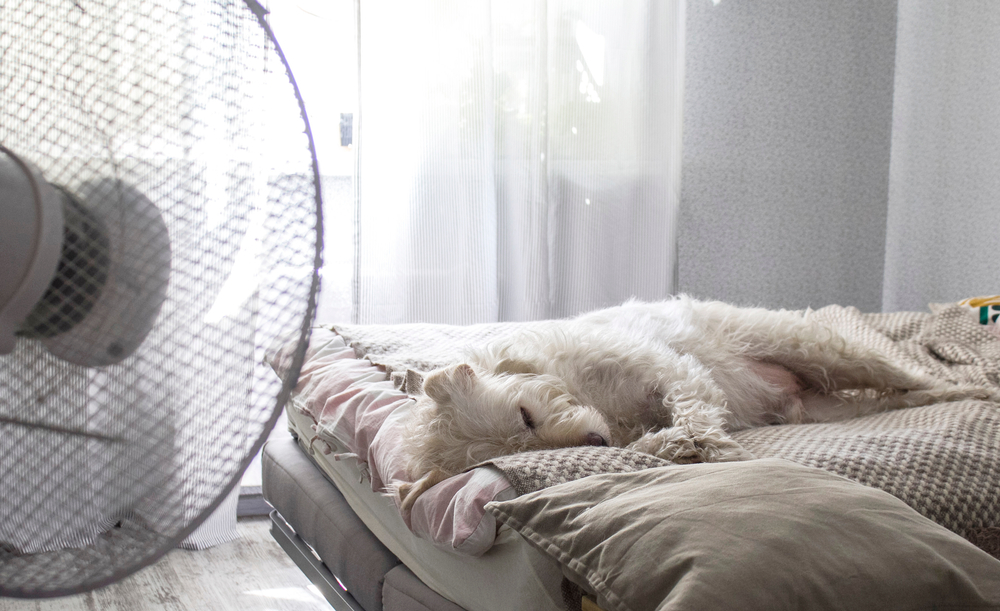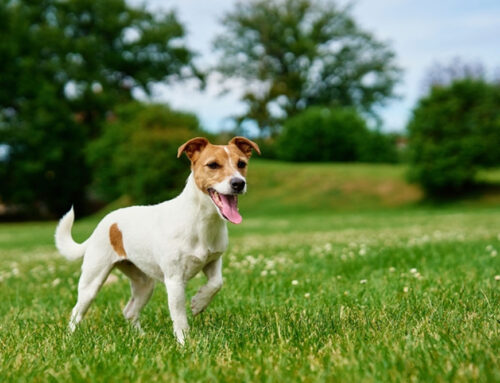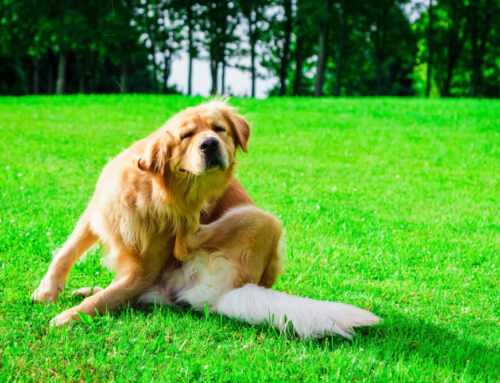Texas heat can be brutal, and in the dog days of summer, don’t let the heat and humidity affect your four-legged friend. Our veterinarians in south Austin want to help by providing information about pet heat safety to counter some common beliefs on the topic.
False belief: “If I can tolerate the heat, my pet will be fine.”
Truth: Humans have sweat glands all over their body, and as moisture evaporates, the skin is cooled. Pets have only a few sweat glands, mostly located in their paws, and they must rely on less efficient means, such as panting, to regulate their body temperature, which makes them more susceptible to heatstroke. Heatstroke occurs when your pet’s body temperature rises above the normal range (i.e., 101 to 102.5 degrees) in response to excessive exercise or elevated air temperatures. Heatstroke is considered a veterinary emergency, because the excessive heat triggers a severe inflammatory response throughout the pet’s body and can affect many systems, including the brain, cardiovascular system, lungs, gastrointestinal tract, kidneys, and coagulation. Signs include:
- Excessive panting — Your pet will start to pant more in an attempt to dispel more heat from their mouth and lungs.
- Drooling — Increased saliva production occurs to aid heat dissipation.
- Red mucous membranes — Vessels in your pet’s mucous membranes and extremities dilate to allow blood flow in these areas and help dispel heat. This causes their mucous membranes to turn red, and as dehydration occurs, their mucous membranes will also become tacky and dry.
- Diarrhea — When the excessive heat damages your pet’s gastrointestinal tract, diarrhea can develop.
- Central nervous system signs — When the heat damages your pet’s brain, they will start to experience signs such as incoordination, loss of consciousness, and seizures.
False belief: “My pet will be fine in the car while I run in the store for a few minutes.”
Truth: Interior vehicle temperatures can soar to dangerous levels quickly, and you must never leave your pet in the car for any reason. Parking in the shade or leaving your windows slightly open will not keep the temperature safe for your pet. If you think you will have to leave your pet in the car while you run errands, you should leave them in your air-conditioned home.
False belief: “Bringing water for my pet is too much of a hassle, and they will be fine for a brief outing.”
Truth: Dehydration predisposes pets to heatstroke, and your pet should have access to fresh water to ensure they stay hydrated, especially on hot, humid days. Take water and a portable bowl on outings, so you can offer your pet a drink at regular intervals. Other ways to ensure your pet stays hydrated include:
- Provide several water sources — Provide multiple water sources throughout your home to make drinking easy and convenient for your pet.
- Clean water bowls daily — Clean your pet’s bowls and add fresh water daily.
- Consider a water fountain — Some pets are attracted to flowing water and will drink more from a water fountain.
False belief: “The heat is good for my senior pet’s joint pain.”
Truth: While all pets are susceptible to heatstroke, senior pets, brachycephalic pets, obese pets, and pets dealing with a health condition are at increased risk. On hot, humid days, keep high-risk pets inside in air-conditioned comfort, except for brief bathroom breaks, preferably taken during the cooler times of the day.
False belief: “My pet enjoys a strenuous game of fetch regardless of the weather.”
Truth: You should restrict your pet’s activity on hot, humid days to prevent heatstroke. Pets can get carried away when enjoying a favorite game, and may not stop to cool down sufficiently. Take frequent breaks in the shade when outside with your pet and, if possible, walk them in the early morning and evening hours to avoid peak heat conditions.
False belief: “My pet’s paws are tough and can handle any surface.”
Truth: Paved surfaces, such as asphalt, can reach temperatures much higher than the ambient temperature, and become a burn hazard for your pet’s paws. Ensure you walk your pet in shady areas or on grassy or sandy surfaces to protect their feet. If this isn’t possible, consider protective booties to shield your pet’s paws.
False belief: “My pet seemed to overheat, but is completely fine after cooling down.”

Truth: If your pet overheats, they can sustain life-threatening internal damage, and they should be evaluated promptly by a veterinary professional in every situation, including when they seemingly return to normal after cooling down. Heatstroke first aid for pets includes:
- Move your pet to a cool area — Take your pet to a cool, well-ventilated area.
- Provide water — Offer your pet water if they are conscious, but don’t attempt to pour the water in their mouth, or force them to drink.
- Take your pet’s temperature — Preferably with a rectal thermometer, take your pet’s temperature to monitor their progress, so you can relay the information to our south Austin veterinarians.
- Cool your pet — Use lukewarm water and wet towels to cool your pet. Never use ice or ice water, which will cause their temperature to fall too quickly, possibly resulting in shock.
- Take your pet to the veterinarian — Once you have started the cooling process, take your pet to the veterinarian as soon as possible.
Don’t let Texas’ brutal heat cause life-threatening consequences for your pet. However, if your pet overheats, contact our veterinarians in south Austin at Oliver Animal Hospital immediately, so we can ensure they get the care they need.







Leave A Comment